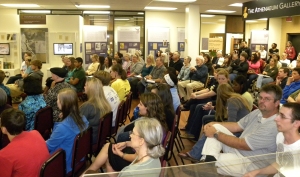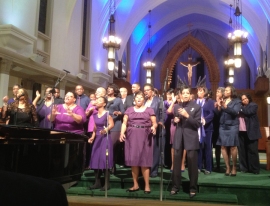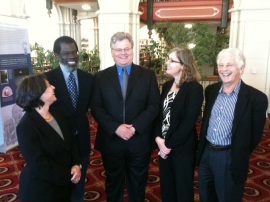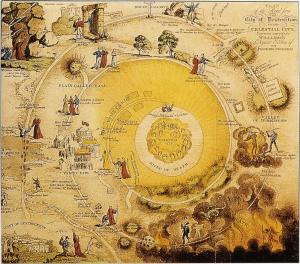A Grand Tour Draws to a Close

A large crowd gathered to hear four Kennesaw State University faculty discuss the history and language of the King James Bible in Kennesaw, GA.
It feels like yesterday that I was drafting the itinerary for the Manifold Greatness traveling exhibition to libraries. Almost two years later, the exhibition has traveled to 40 libraries across the United States, and it wraps up at its final site—Nancy Guinn Memorial Library of the Conyers-Rockdale Library System in Conyers, Georgia—on July 12, 2013. The ALA Public Programs Office has been honored to coordinate the tour to public and academic libraries, who presented a variety of free humanities programs in conjunction with the exhibition.
Host libraries enthusiastically planned for Manifold Greatness. Library patrons were exposed to more than 230 programs related to the King James Bible—and more than 130,000 people visited the exhibition over the course of the project! To illustrate the creative hard work of library hosts, here is a sampling of just a few of the many unique programs presented:
-

The Sacred Praise Chorale chorale at Loyola Marymount University in California. Photo by Jeannine Emmett.
Lecture: “The King’s English in a Tamil Tongue” was presented by Dr. Dyron Daughrity—Pepperdine University Library, Malibu, CA
- Lecture: “King James Bible and Two of Its Famous Contemporaries: William Shakespeare and John Milton” was presented by Drs. Edward Jones and David Anderson, followed by discussion—Oklahoma State University Library, Stillwater, OK
- Lecture: “The Role the KJB Played in Mormonism and the Settlement of the West” was presented by Dr. Philip L. Barlow, Arrington Chair of Mormon History and Culture, Utah State University—University of Wyoming Libraries, Laramie, WY
- Activity: “Illuminations Family Night,” a family activity in which the Utah Calligraphy Artists taught children about illuminating manuscripts—Provo Library, Provo, UT
- Musical performance: “Praise Ye The Lord: A Festival of Hymns Inspired by the King James Bible,” music performance, script, and sing-a-long of hymns—Transylvania County Library, Brevard, NC
-

At Rhodes College in Memphis: Naomi Tadmor, Vincent Wimbush, Hannibal Hamlin, Ena Heller, Robert Alter
Demonstration: “Teen 19th Century Bloggers”; Tracy Honn of Silver Buckle Press demonstrated the use of a nineteenth century printing press for ages 11 to 18—Verona Public Library, Verona, WI
- Lecture: “Covering the Feet: Scatological References in the King James Bible” was presented by Dr. Daniel C. Browning, Jr. who discussed the King James Bible from an archaeologist’s point of view—William Carey University, Hattiesburg, MS
- Presentation: “Impact of Scripture on Dr. Martin Luther King, Jr.,” a lecture given by Reverend O’Neil Wiley, was accompanied by dramatic readings from two of Dr. King’s speeches by University of Mobile theater major Broderick S. Ryans—Ben May Main Library of the Mobile Public Library, Mobile, AL
- Lecture: “The First Editions of the King James Bible: Misprints and Misfortunes” was presented by Dr. Pablo Alvarez, who talked about the printing process that led to errors in the first editions of the King James Bible—Van Wylen Library, Hope College, Holland, MI
- Presentation: “The Family Bible: A Historical and Genealogical Resource” offered owners of family bibles information on how to use their treasured family heirlooms as a tool when doing genealogical and historical research—Kennesaw State University, Kennesaw, GA
- Lecture: “Catholics and the King James Bible: Stories from England, Ireland, and America” was presented by Dr. Ellie Bagley from Middlebury College—Rhodes College, Memphis, TN
In addition to stellar program line-ups, libraries reported that the exhibit provided them with the opportunity to try new programming formats.
Project Director Katy Kelly at the University of Dayton opened up exhibit-related brown bag lunches—typically limited to faculty and staff—to the public. Kelly said the new lunchtime presentations were very well-attended and “brought greater awareness to the local community of the kinds of scholarship and research our faculty undertake.”
Project director Steve Silver of Northwest Christian University commented on the long-term impact of hosting the exhibit. He said, “Connections made with local groups as a result of Manifold Greatness endure after a year and a half since we hosted the exhibit. Those connections would not have been made without the requirements of the grant.”
Even though the exhibition’s grand tour is coming to an end, ALA looks forward to building on the inspiring success of Manifold Greatness in our future work with libraries.
Jennifer Dominiak is a program officer for exhibitions in the Public Programs Office at the American Library Association.







